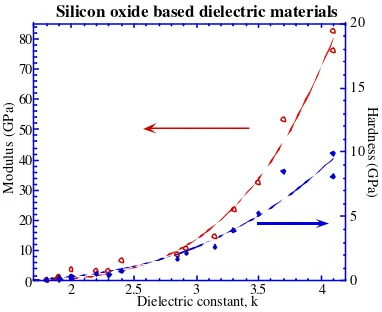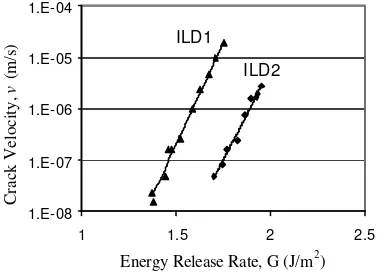Cohesive Strength Characterization of Brittle Low-k Films
Guanghai Xu, Jun He, Eb Andideh, Jeff Bielefeld, and Tracey Scherban
Intel Corporation, Logic Technology Development Hillsboro, OR 97124
Abstract
The cohesive strength of low k dielectric films is an important property in predicting thermo -mechanical integrity of the Cu/low k interconnect structure. An approach to measure the cohesive strength of brittle low k films is presented, in which residual stress, elastic modulus and film thickness, are considered. The importance of residual film stress in cohesive failures is demonstrated.
Introduction
The drastic deterioration in mechanical properties with the introduction of “low-k” dielectric films has led to serious process challenges in both integration and assembly. As a result, the thermo -mechanical stability of the Cu-low k interconnect structure has emerged as a major reliability concern, with interfacial delamination and ILD cohesive fracture being the leading failure modes. Failures can occur during fab processing when mechanical or thermal stresses are introduced (e.g., chemical mechanical polishing (CMP) or high-temperature processsteps), during packaging due to thelarge difference in thermal expansion coefficients between the die and package substrates, or during reliability testing (temperature cycling or highly accelerated stress testing).
Figure 1 shows the drop in mechanical strength as k is reduced. The low k films typically have dielectric constant less than 3 such that modulus E is generally less than 10 GPa(vs. ~75GPa for silica). The reduction in k is achieved through the introduction of C-C bonding or the incorporation of porosity. A fundamental change of the low-k ILD films is their tensile intrinsic stress, compared with the compressive stresses in conventional SiO2-based films, shown in Figure 2. Consequently, cohesive failure in ILD films becomes one of the dominant failure modes for interconnect system.
0 10 20 30 40 50 60 70 80
0 5 10 15 20
2 2.5 3 3.5 4
Silicon oxide based dielectric materials
Modulus (GPa)
Hardness (GPa)
Dielectric constant, k 0
10 20 30 40 50 60 70 80
0 5 10 15 20
2 2.5 3 3.5 4
Silicon oxide based dielectric materials
Modulus (GPa)
Hardness (GPa)
Dielectric constant, k
Figure 1. Mechanical properties of low K films as function of dielectric constant.
-300 -200 -100 0 100
1 10 100 1000
Modulus (GPa)
Intrinsic Film Stresses (MPa)
Figure 2. Intrinsic film stress vs. modulus.
be able to accurately measure thin film cohesion. In this paper a method for the measurement of cohesive strength is presented. Further the relationship between cohesive strength, other mechanical properties and reliability results are presented.
Experiments
The channel cracking technique, used for fracture toughness measurements, is illustrated in Figure 3. Samples are cleaved from wafers consisting of blanket ILD films deposited on a silicon substrate. The samples are loaded as shown in the figure.
P/2
Figure 3. Channel cracking configuration.
The channel cracking technique has been described previously [3]. The difference here is the lack of a metal underlayer beneath the brittle ILD film. Therefore, the calculation must be modified accordingly. Here the total stress on the film is calculated as
s second term represents the external stress applied to the film through bending. The fracture cohesive energy release rate is [4]
f Young’s modulus and Poisson’s ratio for the film and Si, respectively. And gel is a constant, which depends on the elastic mismatch of the film and substrate; it is calculated using finite element modeling. During testing, crack growth was observed through an optical microscope and
velocities were recorded at corresponding loads. Upon completion of testing, a curve of crack growth velocity as a function of G was generated. Gc is defined as the value at v=0.1µm/s in order to compare different ILD materials.
Results
Figure 4 is a plot of crack propagation velocity as a function of applied energy release rate for two different low k ILD films. The results show that ILD2 is stronger than ILD1. However, this is not consistent with other mechanical tests, such as bump shear, in which shear and tensile forces are applied on the base of the bump to simulate stresses induced during packaging. In the bump shear test, ILD1 required higher loads to cause failure than ILD2.
1.E-08
Energy Release Rate, G (J/m2)
Crack Velocity,
v
(m/s)
ILD1
ILD2
Figure 4. Crack growth velocity as function of energy release rate for 2 ILD films.
1.E-08 1.E-07 1.E-06 1.E-05 1.E-04
20 25 30 35 40 45
Cohesive Strength, σs(MPa)
Crack Velocity,
v
(m/s) ILD2
ILD1
Figure 5. Crack velocity as function of cohesive strength, normalized to 1.5µm film thickness.
The residual stress for ILD1 and ILD2 are 60MPa and 70MPa, respectively. Figure 5 shows the cohesive strength normalized to 1.5um film thickness at different crack velocities. The results show that ILD1 is stronger than ILD2, consistent with other mechanical tests.
One more important application of the channel cracking measurement is to predict critical thickness, hc, the threshold thickness at which the film will crack in the absence of external stress; hc can be calculated as follows:
2 f 2
f
c h 0
h
σ σ
= (4)
Figure 6 is a plot of measured cohesive strength as a function of film elastic modulus, showing a linear increase of cohesive strength with film modulus. As modulus increases, the k value is expected to increase too. In low k film development there is a tradeoff between optimization of mechanical properties such as modulus and cohesive strength and reduction in k value to meet requirements in both performance and reliability.
0 20 40 60 80
0 5 10 15 20 25
Film Modulus, E(GPa)
Cohesive Strength,
s
(MPa)
Figure 6. Cohesive strength as function of film modulus. Cohesive strength is normalized to 1.5µm film thickness and at 0.1µm/s.
Conclusions
Introduction of low k materials presents serious reliability challenges due to their drastic deteriorating mechanical properties. Cohesive/adhesive strength and intrinsic film stress identified as critical mechanical properties for brittle low-k ILD. A new metric “cohesive strength at fixed film thickness” for thin film cohesion has been proposed and validated. It was also found that the film cohesive strength linearly increases while film modulus increases.
Reference
[1] Q. Ma, "A Four-Point Bending Technique for Studying
Subcritical Crack Growth in Thin Films and at Interfaces," J.
Materials Research, 12, p.840-845, 1997.
[2] E. Andideh, and T. Scherban et al, “Interfacial Adhesion
of Copper-Low k Interconnects”, Proceedings of the IEEE 2001 IITC, p.257-259, 2001.
[3] Q. Ma et al, “Channel Cracking Technique for Toughness
Measurement of Brittle Dielectric Thin Films on Silicon Substrates”, Materials Reliability in Microelectronics VIII,
Mater. Res. SocSymposium; vol. 365 p.331-336, 1998. [4] J. W. Hutchinson and Z. Suo, “Mixed Mode Cracking in
Layered Materials,” Advances in Applied Mechanics, 29,


